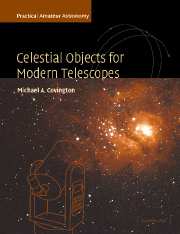Book contents
- Frontmatter
- Contents
- Preface
- Part I Amateur astronomy
- 1 Using this book effectively
- 2 Observing sites and conditions
- 3 The Moon, the Sun, and eclipses
- 4 The planets
- 5 Comets, asteroids (minor planets), and artificial satellites
- 6 Constellations
- 7 Stars – identification, nomenclature, and maps
- 8 Stars – physical properties
- 9 Double and multiple stars
- 10 Variable stars
- 11 Clusters, nebulae, and galaxies
- Part II 200 interesting stars and deep-sky objects
- Appendices
- Index
10 - Variable stars
Published online by Cambridge University Press: 22 September 2009
- Frontmatter
- Contents
- Preface
- Part I Amateur astronomy
- 1 Using this book effectively
- 2 Observing sites and conditions
- 3 The Moon, the Sun, and eclipses
- 4 The planets
- 5 Comets, asteroids (minor planets), and artificial satellites
- 6 Constellations
- 7 Stars – identification, nomenclature, and maps
- 8 Stars – physical properties
- 9 Double and multiple stars
- 10 Variable stars
- 11 Clusters, nebulae, and galaxies
- Part II 200 interesting stars and deep-sky objects
- Appendices
- Index
Summary
Overview
All stars are variable – it's just that some of them have not varied appreciably during human history. Every star changes brightness as it ages, and many stars pulsate – that is, they get brighter and dimmer in a regular cycle.
Besides being interesting to watch, variable stars provide opportunities for amateurs to contribute to scientific knowledge. Much of the year-by-year monitoring of variable stars is done by amateurs, and amateurs discover many novae and supernovae. A large telescope is not required; some of the most productive observers use small, wide-field instruments or even binoculars.
Amateur variable-star work is coordinated by the B.A.A. (p. 30) and the American Association of Variable Star Observers (AAVSO, 25 Birch St., Cambridge, MA 02138, U.S.A., http://www.aavso.org). The AAVSO maintains a web site with current information on thousands of stars and issues bulletins about unexpected phenomena.
Besides AAVSO and B.A.A. training materials, two very good guides to variable-star observing are the book Observing Variable Stars, by David H. Levy (Cambridge University Press, 1998), and the chapter on variable stars by M. Dumont and J. Gunther in Patrick Martinez' The Observer's Guide to Astronomy, vol. 2, pp. 775–846. Levy's book is designed for beginners and casual skygazers; Dumont and Gunther's treatment of the subject is more technical.
- Type
- Chapter
- Information
- Celestial Objects for Modern TelescopesPractical Amateur Astronomy Volume 2, pp. 132 - 143Publisher: Cambridge University PressPrint publication year: 2002

